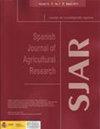一种考虑植物、害虫、农药和喷洒设备对生物药效综合影响的农药用量优化方法
IF 0.8
4区 农林科学
Q3 AGRICULTURE, MULTIDISCIPLINARY
引用次数: 0
摘要
研究目的:建立一种考虑植物、害虫、农药和喷雾设备对生物效率的综合影响的农药剂量优化方法。研究领域:印度哥印拜陀泰米尔纳德邦农业大学农业工程学院和研究所。材料和方法:受控液滴施加器产生200至50μm的液滴。可以通过定时喷雾来控制预设液滴大小的目标叶片的沉积密度。在不同液滴密度下,在每种农药(亚胺虫脒17.8%SL)的剂量和液滴大小下进行了一系列生物测定,以确定以未成熟棉花为食的棉蚜(Aphis gossypii)和茉莉(Amrasca biguttula)的死亡率。计算导致50%和90%死亡率所需的每个目标区域的液滴数量(LN50和LN90)产生了一系列模型曲线。对喷雾装置(带电静电喷雾)计算出的农药最佳剂量进行了现场试验,以评估喷雾对棉蚜和大蠊的生物有效性。主要结果:与LN90剂量为110 g a.i.L-1时生物有效性为91%的不带电喷雾相比,该喷雾对棉蚜的生物有效性达89%。使用静电喷雾,在剂量为110 g A.i.L-1的LN90下,它对大灰蝶的有效性为91%,对不带电的喷雾器的有效性是98%。研究重点:这种通用的建模方法可以有效地计算任何植物、害虫、农药和喷雾设备组合的最佳农药剂量。本文章由计算机程序翻译,如有差异,请以英文原文为准。
A method to optimize the pesticide dose considering the combined influence of plant, pest, pesticide, and spray equipment on bioefficacy
Aim of the study: To develop a method to optimize the pesticide dose considering the combined influence of plant, pest, pesticide, and spray equipment on bioefficacy.
Area of study: Agricultural Engineering College and Research Institute, Tamil Nadu Agricultural University, Coimbatore, India.
Material and methods: A controlled droplet applicator generated droplets from 200 to 50 μm. The target leaf's deposition density of a preset droplet size can be controlled by timing the spray. A sequence of bioassays was performed at various droplet densities at each pesticide (imidachloprid 17.8% SL) dose and droplet size to determine the mortality of cotton aphids (Aphis gossypii) and jassids (Amrasca biguttula) feeding on immature cotton plants. Calculating the number of droplets per target area needed to cause 50% and 90% mortality (LN50 and LN90) yielded a series of model curves. Field tests were done on the computed optimal doses of the pesticide for a spray apparatus (electrostatically charged spray) to assess the spray's bioefficacy against A. gossypii and A. biguttula.
Main results: In comparison to uncharged mist blower spray, which had a bioefficacy of 91% for an LN90 dose of 110 g a.i. L-1, the spray had an 89% bioefficacy on A. gossypii. Using the electrostatic spray, it was 91% effective against A. biguttula and 98% effective against an uncharged mist blower at a dose of 110 g a.i. L-1 of LN90.
Research highlights: This generalized method of modelling could effectively compute the optimal pesticide dose for any plant, pest, pesticide, and spray equipment combination.
求助全文
通过发布文献求助,成功后即可免费获取论文全文。
去求助
来源期刊

Spanish Journal of Agricultural Research
农林科学-农业综合
CiteScore
2.00
自引率
0.00%
发文量
60
审稿时长
6 months
期刊介绍:
The Spanish Journal of Agricultural Research (SJAR) is a quarterly international journal that accepts research articles, reviews and short communications of content related to agriculture. Research articles and short communications must report original work not previously published in any language and not under consideration for publication elsewhere.
The main aim of SJAR is to publish papers that report research findings on the following topics: agricultural economics; agricultural engineering; agricultural environment and ecology; animal breeding, genetics and reproduction; animal health and welfare; animal production; plant breeding, genetics and genetic resources; plant physiology; plant production (field and horticultural crops); plant protection; soil science; and water management.
 求助内容:
求助内容: 应助结果提醒方式:
应助结果提醒方式:


